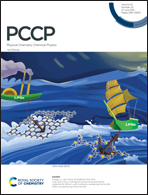Exploring the stability of inhibitor binding to SIK2 using molecular dynamics simulation and binding free energy calculation†
Abstract
Salt inducible kinase 2 (SIK2) is a calcium/calmodulin-dependent protein kinase-like kinase that is implicated in a variety of biological phenomena, including cellular metabolism, growth, and apoptosis. SIK2 is the key target for various cancers, including ovarian, breast, prostate, and lung cancers. Although potent inhibitors of SIK2 are being developed, their binding stability and functional role are not presently known. In this work, we studied the detailed interactions between SIK2 and four of its inhibitors, HG-9-91-01, KIN112, MRT67307, and MRT199665, using molecular docking, molecular dynamics simulation, binding free energy calculation, and interaction fingerprint analysis. Intermolecular interactions revealed that HG-9-91-01 and KIN112 have stronger interactions with SIK2 than those of MRT199665 and MRT67307. The key residues involved in binding with SIK2 are conserved among all four inhibitors. Our results explain the detailed interaction of SIK2 with its inhibitors at the molecular level, thus paving the way for the development of targeted efficient anti-cancer drugs.



 Please wait while we load your content...
Please wait while we load your content...